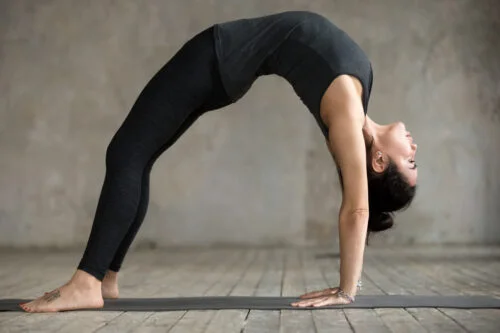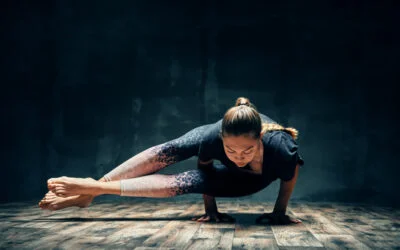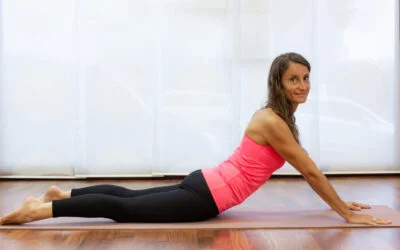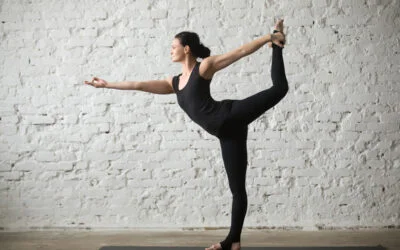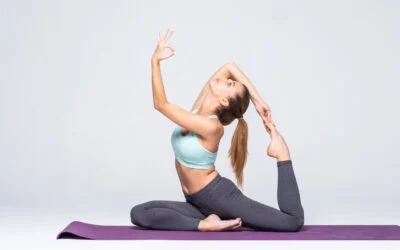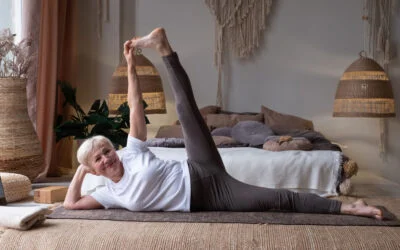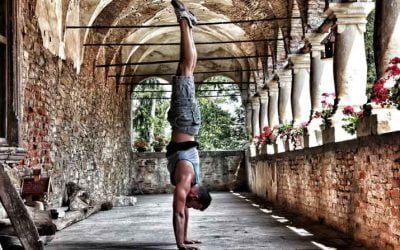Upward Bow Pose, also known as Urdhva Dhanurasana in Sanskrit, is a dynamic and energizing yoga posture that offers a myriad of benefits for both the body and mind. This backbend pose is a challenging yet rewarding asana that stretches and strengthens the entire body, while also promoting flexibility and emotional well-being.
In this article, we will explore the various benefits of Upward Bow Pose, discuss the proper technique to perform it, and explore some of its popular variations. Whether you are a beginner or an experienced yogi, this guide will provide you with a comprehensive understanding of Upward Bow Pose and how to incorporate it into your yoga practice.
Benefits of Upward Bow Pose Yoga.
1. Strengthens the back and core muscles.
Upward Bow Pose is an excellent way to strengthen the back muscles, including the erector spinae, which helps maintain a healthy spine. Additionally, it engages the core muscles, including the abdominals and obliques, enhancing overall stability and promoting good posture.
2. Opens the chest and shoulders.
Regular practice of this asana expands the chest, stretches the pectoral muscles, and opens the shoulders. This helps counteract the forward bending posture often associated with sedentary lifestyles, improving breathing capacity and alleviating tension in the upper body.
3. Increases flexibility.
Upward Bow Pose stretches and lengthens the entire front body, including the hip flexors, quadriceps, and abdominal muscles. With consistent practice, it gradually enhances flexibility in these areas, allowing for greater mobility and range of motion.
4. Boosts energy and relieves fatigue.
Performing Upward Bow Pose creates a gentle compression in the spine, stimulating the nervous system and boosting energy levels. This pose also helps alleviate fatigue, as the physical exertion involved activates the body’s energy centers and increases circulation throughout the entire system.
5. Enhances mood and reduces stress.
The practice of backbends, such as Upward Bow Pose, can have a positive impact on mood and emotional well-being. This pose stimulates the release of endorphins, the body’s natural feel-good hormones, promoting a sense of happiness and reducing symptoms of stress, anxiety, and depression.
6. Improves digestion and detoxification.
Upward Bow Pose stimulates the abdominal organs, including the liver, kidneys, and pancreas, which can aid in digestion and detoxification processes. The gentle compression and extension of the abdomen during this pose help massage these organs, enhancing their functionality and promoting a healthy digestive system.
7. Develops balance and proprioception.
Balancing the body on the hands and feet in Upward Bow Pose challenges and improves proprioception, which is the body’s awareness of its position in space. This pose requires focus and concentration, developing a sense of balance both physically and mentally.
8. Cultivates a sense of empowerment and self-confidence.
Performing Upward Bow Pose requires strength, flexibility, and trust in oneself. Consistent practice of this challenging asana can lead to a greater sense of empowerment, self-confidence, and self-esteem, both on and off the mat.
| 💡 Tips FreakToFit.com Incorporating Upward Bow Pose into your yoga practice can offer a wide array of benefits for the body and mind. However, it is essential to practice under the guidance of a qualified yoga instructor to ensure proper alignment and avoid any potential injuries. |
How to do Upward Bow Pose Yoga?
If you’re ready to embark on the journey of practicing Upward Bow Pose, here’s a step-by-step guide to help you get started:
1. Warm up.
Before attempting any challenging pose, it’s crucial to warm up your body properly. Begin with a few rounds of Sun Salutations or gentle stretches to awaken your muscles and prepare them for the upcoming intensity.
2. Lie down on your back.
Start by lying flat on your back, with your knees bent and your feet hip-width apart. Place your arms alongside your body, with your palms facing down and fingers pointing towards your feet.
3. Position your hands.
Bend your elbows and bring your palms next to your ears, fingers pointing towards your shoulders. Make sure your fingertips are facing towards your feet, allowing your elbows to point upwards.
4. Engage your legs and feet.
Press your feet firmly into the ground, activating your leg muscles. Keep your thighs parallel to each other and ensure your knees are pointing straight forward.
5. Inhale, lift your hips.
As you inhale deeply, press your palms and feet into the ground, simultaneously lifting your hips and lower back off the floor. Gradually, use your core strength to lift your entire torso, creating a gentle backbend.
6. Find stability.
Once your torso is fully lifted, distribute your weight evenly between your hands and feet. Engage your glutes, inner thighs, and lower abdominal muscles to maintain stability and prevent excessive strain on your lower back.
7. Open your chest.
Continue to inhale deeply, as you gently push your chest forward and upward. Allow your shoulder blades to draw towards each other, opening your heart center and expanding your chest. Be mindful not to strain your neck; keep it neutral and relaxed.
8. Take steady breaths.
Stay in the pose for a few deep breaths, finding a balance between effort and ease. If you’re comfortable, you can gently shift your gaze towards the wall behind you, maintaining a soft focus without straining your neck.
9. Release the pose.
To come out of Upward Bow Pose, exhale slowly and lower your body back down to the ground one vertebra at a time. Start from your upper back, then mid-back, and finally your lower back. Allow your body to rest on the mat, releasing any tension or effort.
10. Rest and recover.
After practicing Upward Bow Pose, take a moment to rest in Savasana (Corpse Pose) to allow your body and mind to fully integrate the benefits of the pose. Stay in Savasana for at least a few minutes, focusing on your breath and embracing a sense of relaxation.
| 💡 Tips FreakToFit.com Remember, as with any yoga pose, it’s important to listen to your body and practice with awareness. If you’re new to Upward Bow Pose or experiencing any discomfort, it’s advisable to seek guidance from a qualified yoga instructor. Enjoy your practice and embrace the transformative journey that Upward Bow Pose can offer! |
Variations of Upward Bow Pose Yoga.
Variations of Upward Bow Pose Yoga, also known as Urdhva Dhanurasana, offer a wide range of modifications and progressions that allow practitioners to explore and deepen their practice. Here are some notable variations:
1. Supported Upward Bow Pose.
This variation involves the use of props such as blocks, bolsters, or a chair to provide support and stability. By elevating the hands or feet, practitioners can gradually build strength and flexibility while reducing strain on the wrists or shoulders.
2. One-legged Upward Bow Pose.
As the name suggests, this variation involves lifting one leg off the ground while maintaining the full expression of Upward Bow Pose. This variation challenges balance and core stability while increasing hip flexibility and strength in the standing leg.
3. Bound Upward Bow Pose.
In this variation, the hands clasp together behind the back, creating a bind. This variation intensifies the stretch across the chest and shoulders while requiring more openness in the shoulders and thoracic spine.
4. Inverted Upward Bow Pose.
By practicing Upward Bow Pose with the feet elevated, against a wall, or on an incline, practitioners can experience an inversion-like effect. This variation offers the benefits of an inversion, such as increased blood flow to the head and a rejuvenating effect on the nervous system, while simultaneously strengthening the legs and back.
5. Upward Bow Pose with Leg Variations.
Practitioners can explore different leg positions while in Upward Bow Pose, such as extending one leg straight up towards the ceiling or bending one knee and placing the foot on the opposite thigh. These variations challenge balance, hip flexibility, and core strength while adding a playful element to the pose.
6. Upward Bow Pose with Props.
The use of props like yoga wheels, yoga blocks, or straps can provide additional support and assist in deepening the pose. These props can help practitioners to gradually work towards a deeper backbend, increase spinal mobility, and open the chest and shoulders.
7. Dynamic Upward Bow Pose.
This variation involves transitioning in and out of Upward Bow Pose with fluidity and control. Practitioners can explore flowing movements, such as lifting one leg at a time or rocking back and forth, to enhance body awareness, coordination, and overall strength.
| 💡 Tips FreakToFit.com Remember, it is essential to approach these variations with caution and respect for your body’s limitations. Practicing under the guidance of a qualified yoga instructor can ensure proper alignment, prevent injuries, and help you progress safely in your yoga journey. |
Who can do Upward Bow Pose Yoga?
Anyone who has a basic level of flexibility and strength can do Upward Bow Pose yoga, also known as Urdhva Dhanurasana. This pose requires the practitioner to have open shoulders, a strong core, and a flexible spine. Beginners may find it helpful to warm up with preparatory poses such as Bridge Pose or Camel Pose before attempting Upward Bow.
It is important for individuals with any pre-existing injuries or medical conditions to consult with a qualified yoga instructor or healthcare professional before attempting this pose. With consistent practice, patience, and proper alignment, anyone can gradually work towards achieving Upward Bow Pose.
Who should avoid Upward Bow Pose Yoga?
Upward Bow Pose Yoga, also known as Wheel Pose, is a challenging and intense backbend that requires a certain level of strength, flexibility, and experience. As such, individuals who have certain health conditions or injuries should avoid practicing this pose. People with neck or back injuries, particularly those affecting the spine, should steer clear of Upward Bow Pose as it can put excessive strain on these areas.
Additionally, individuals with wrist, shoulder, or elbow problems may also find this pose uncomfortable or aggravating. It is crucial to listen to your body and consult with a qualified yoga instructor or healthcare professional before attempting any advanced poses to ensure your safety and well-being.
Precautions to take while doing Upward Bow Pose Yoga.
- Warm up properly before attempting the Upward Bow Pose to prepare your body for the challenging movements.
- Make sure you have enough space around you to fully extend your body and avoid any obstacles or furniture that could hinder your practice.
- Listen to your body and do not push yourself beyond your limits. Start with gentle backbends and gradually increase the intensity over time.
- Engage your core muscles throughout the pose to protect your lower back and maintain stability.
- Place a yoga mat or blanket under your head and neck for support and to prevent any discomfort.
- Keep your neck relaxed and avoid straining or putting excessive pressure on it.
- Do not force your body into the pose if you feel any pain or discomfort. Modify the pose or seek guidance from a qualified yoga instructor.
- If you have any pre-existing neck or back injuries, consult with a medical professional or a yoga therapist before attempting the Upward Bow Pose. They can provide you with personalized advice and modifications.
- Breathe deeply and mindfully throughout the pose, allowing your breath to guide and support your movements.
- Always end your practice with a gentle cool-down and relaxation to allow your body to recover and avoid any post-yoga soreness.
Bottom Line.
The Upward Bow Pose, also known as Urdhva Dhanurasana, is a challenging yet rewarding yoga pose that offers numerous physical and mental benefits. By stretching and strengthening various muscles, this pose helps improve flexibility, enhance core stability, and promote better posture. Additionally, it stimulates the respiratory and circulatory systems, promoting a healthy and balanced body.
Moreover, the Upward Bow Pose encourages mental focus and concentration, relieving stress and anxiety. As with any yoga pose, it is important to practice under the guidance of a qualified instructor and listen to your body’s limitations. With dedication and patience, the Upward Bow Pose can be a powerful addition to any yoga practice, bringing about a sense of strength, openness, and overall well-being.

 Workout
Workout
 Meditation
Meditation


 Stories
Stories


 Podcast
Podcast E-book
E-book